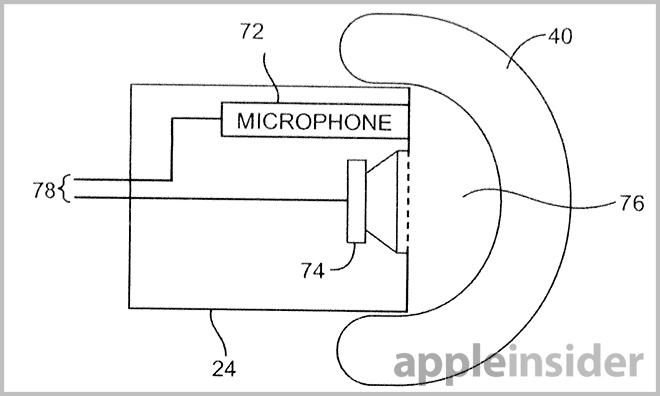An Apple patent application discovered on Thursday describes a set of earbud type headphones that automatically adjust audio output based on seal quality, with necessary impedance data gathered by built-in microphones or electrical current measurements.
As published by the U.S. Patent and Trademark Office on Thursday, Apple's "Electronic device and headset with speaker seal evaluation capabilities" details a new type of self-calibrating earbud that can deliver enhanced audio reproduction over a wide variety of ear shapes and sizes. Also alluded to in the patent are noise canceling headphones which rely heavily on good earbud-to-ear seals to operate.
Apple's invention is primarily aimed at earbud headphones, which are designed to create a seal in a user's ear that helps reduce ambient noise while retaining a compact form factor. When an earbud does not create a proper seal, however, these properties are negatively impacted.
Illustration of good seal (top) and poor seal (bottom).From the filing's description:
The quality of the seals that are formed between earbuds and a user's ears affects performance. For example, satisfactory noise cancellation can become difficult when is high-quality seal is not present. Poor earbud-to-ear seals can also affect audio quality in other ways. For example, left-right balance (volume) and equalization can be affected by seal quality.
To evaluate this seal, the invention proposes measuring the impedance of the speakers by taking current measurements, acoustic measurements with a microphone, or both.
As earbud impedance may vary as a function of signal frequency, impedance-versus-frequency curves can also be mapped and compared against to reveal poor seals. In addition, these curves can be used to adjust speaker output to compensate for inadequate performance.
Impedance-versus-frequency curve. Good seal represented by solid line, poor seal by dashed line.The filing details a number of techniques to measure impedance levels, including current sensing circuitry. Test tones can also be used in conjunction with microphones to assess disparity in output and input amplitudes. In the case of noise-canceling headphones, microphones are disposed near the ear to measure ambient noise, and the amount of required noise cancellation can be used to judge whether a seal is good.
When a poor seal is detected, actions can take the form of warnings displayed on a user's device. Alternatively, self-adjustment steps can include balance, equalization, and noise cancellation circuitry adjustments.
Apple's self-evaluating, self-adjusting earbud patent application was first filed for in February 2013 and credits Victor Tiscareno, Jeffrey J. Terlizzi, Wendell B. Sander and Christopher Todd Beauchamp as its inventors.
 Mikey Campbell
Mikey Campbell








-m.jpg)






 Thomas Sibilly
Thomas Sibilly
 Wesley Hilliard
Wesley Hilliard
 Marko Zivkovic
Marko Zivkovic

 Malcolm Owen
Malcolm Owen

 Amber Neely
Amber Neely










30 Comments
It's about time Apple came up with really good in-ear earphones... I don't understand how they have been offering such poor ones up to now, it's so not like them and definitely not what you expect for products of that cost .... Their offering last year was abysmal... Those earphones will NOT stay put in my ears!!
Apple'd better make it as soon as possible. Honestly apple anual upgrade is way behind time.
This
The best earbuds that will fit perfectly are the expensive ones that are custom made to fit the user's ears. But most people can't afford them. Apple will only make something they feel is as good as they can get while still being able to market in the $30 range.
I've don't use Apple earphones but have family and friends who love the earpods. If someone wants quality earphones they don't come cheap!